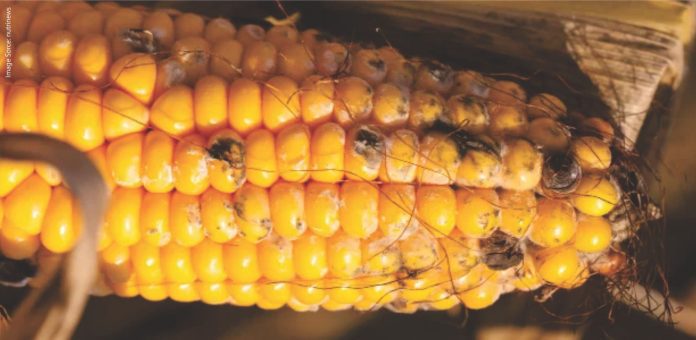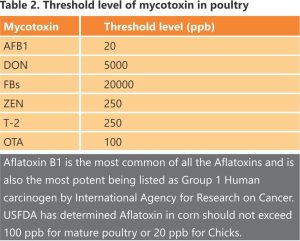Mycotoxins are highly toxic secondary metabolites produced by fungi that are commonly seen as natural contaminants in agricultural commodities globally.
Exposure to these toxins can lead to severe health problems in humans, animals, and poultry birds. In a 2013 worldwide mycotoxin survey, it was discovered that nearly 81% of the 3000 samples studied had at least one mycotoxin. According to the Food and Agriculture Organization, Mycotoxins affect around 25% of crops grown globally each year. Unfortunately, this leads to an annual loss of about 1 billion metric tons of food, feed, and other food products. Crops that are frequently affected by aflatoxins, such as B1, B2, G1, and G2, include cereal grains and oil cakes. However, it is important to note that Aflatoxin M1 can also be detected in the milk from animals that have been fed contaminated feeds.
The issue of Mycotoxicosis is a panoptic challenge, responsible for increasing animal and human health risks, while also causing considerable economic losses to the food and feed industry.
Predisposing Conditions Leading to Mould Growth and Mycotoxins Production
Under favourable conditions, mould growth occurs in several raw materials. Some of the most important factors that predispose towards mould growth are:
- Physical Factors
- Moisture content
- High humidity
- Temperature
- Mechanical damage
Chemical Factors
- pH
- Composition of substrate
Biological Factors
- Crop susceptibility
- Presence of insects and specific strains
- Storage and Processing
- Improper moisture levels
Major Mycotoxins in the Poultry Feed and their effects
Historically, the discovery of Aflatoxins was a consequence of the death of 1 lac turkey poults, ducklings, and chicks in England in 1960. This incident was later referred to as “Turkey X Disease” and was found to be caused by contamination of A. flavus from Brazilian peanut meal used in poultry feed.
High levels of mycotoxins in poultry feed can lead to acute conditions, which can have serious health implications such as increased mortality and a significant decrease in poultry production performance. On the other hand, chronic or masked mycotoxins can affect both human and animal health as well as result in economic losses.
Human Exposure and Implications
Humans can be exposed to mycotoxins through ingestion, dermal contact, or inhalation. The severity of mycotoxicosis depends on age, nutrition, exposure levels, and symptoms may include:
- Abdominal pain
- Nausea
- Vomiting
- GI bleeding
- Palpable liver
- Fever
- Swollen legs, etc.
- Cancer, DNA mutations, Teratogenic effects, Nephrotoxicity, neurotoxicity etc. can be certain chronic implications
Mycotoxin Cases in Humans
Taiwan Outbreak
Back in 1967, an outbreak occurred in two rural villages in Taiwan where 26 people consumed moldy rice and experienced symptoms such as edema, abdominal pain, and vomiting, with a palpable liver. There were three fatal cases in children between 4-8 years. Later, the etiology was traced to Aflatoxin B1.
In October 1974, post heavy rains in 150 villages of Gujarat and Rajasthan, few people consumed contaminated grain for lack of alternate foodstuffs. Afterwards many experienced symptoms of liver injury with vomiting, anorexia, jaundice, and ascites. Analysis of the mouldy corn revealed heavy aflatoxin contamination ranging from 6.25 to 15.6 mg/kg.
International Agency for Research on Cancer evaluated the carcinogenic potential of Aflatoxin, ochratoxin, Trichothecenes, Zearalenone and Fumonisin. They determined that naturally occurring Aflatoxins are carcinogenic to humans and have been classified as Group 1. Ochratoxin and Fumonisin have been classified as possible carcinogens, falling under Group 2B. Trichothecenes and Zearalenone, on the other hand, have not been classified as human carcinogens and are in Group 3.
Aflatoxins are found to be toxic, mutagenic, teratogenic, carcinogenic, and immunosuppressive. The liver is particularly susceptible to damage from these toxins. Aflatoxins have also been found to be associated with a protein-energy malnutrition known as Kwashiorkor while Fumonisins are probably linked to borborygmy, abdominal pain, and diarrhoea. The toxic effects of Trichothecene result in severe necrosis of the oral mucosa and skin in contact with the toxin, acute effect on the gut and reduced bone marrow and immune function. Similarly, ochratoxin and T-2 toxin can also be present in poultry products, making them of significant concern for human health.
Multiple Mycotoxin Interactions
Interactions may occur when two or more mycotoxins are present in feed, possibly due to synergistic or additive effects. Some probable sources are:
1. A single mold carrying multiple toxins on a single commodity.
2. Multiple molds carrying separate toxins on a single commodity simultaneously.
3. Various sources of the same commodity carrying separate contaminations are combined to prepare feed.
4. Different sources of different commodities carrying separate toxins are combined to prepare feed.
Detection of Mycotoxins
- Enzyme-linked immunosorbent assay (ELISA)
- High-performance liquid chromatography (HPLC)
- Liquid chromatography coupled to (tandem) mass spectrophotometry (LC-MS/MS)
The most recent technique, that is, liquid chromatography coupled to (tandem) mass spectrophotometry (LC-MS/MS) has helped to detect hundreds of mycotoxins simultaneously in a sample.
Prevention and Control
Preventing mould growth and mycotoxin production is very important to the feed manufacturers and livestock producers. Some of the traditional and advanced methods to prevent and control the problem of mycotoxicosis are as follows:
Early Harvesting, Proper Drying and Storage
The best prevention strategy begins in the field itself. Pre-harvest control of mycotoxin production and post-harvest mitigation of contamination represents the most effective approach to limiting mycotoxins in food and feed.
Grains and feed ingredients with over 13% moisture content are susceptible to mold growth. The moisture content of feed ingredients is significantly affected by high humidity levels in storage environments. Proper ventilation in the godown aids in removing moisture from the material and the facility.
Biological Control
There are effective biological detoxification methods available for reducing mycotoxins in food. One such method is biotransformation, which uses enzymes to convert mycotoxins into less or non-toxic metabolites. There is also growing interest in genetically modifying cereals, but it is important to ensure that it does not have any negative impact on human health. Another promising approach is the use of nanotechnology to reduce mycotoxin production, which can help to improve food hygiene and quality, and extend the shelf life of food products.
Chemical Control
Treating feeds with acid or alkali, such as Ammonia, CaOH, or monomethylamine, can consistently decrease mycotoxin levels.
When using highly degradable oil cakes like groundnut as a feed ingredient, it is beneficial to reduce its degradability in the rumen. This can be done through protection, either by formaline treatment or heat treatment. The objective is to decrease the breakdown of proteins into ammonia, which is not useful to the animal and must be excreted as urea through the liver. Formalin treatment not only protects proteins but also halts the growth of fungi, preventing further aflatoxin production in the oil cake.
Physical Control
There are several physical methods, such as sanitation, sorting, sieve cleaning, and washing, that can help control the problem of moulds or mycotoxins. However, these methods have limited effectiveness. Thermal treatment is another option for controlling mould growth, but unfortunately, mycotoxins tend to be resistant to high temperatures.
Use of Mycotoxin binders
A highly effective method for managing mycotoxicosis is to decrease bioavailability by incorporating mycotoxin adsorbing agents into feed such as binding agents or adsorbents, like HSCAS (Hydrated Sodium and Calcium Aluminosilicate). An ideal mycotoxin binder should have specific qualities such as:
- Broad spectrum irreversible binding
- Ideal thermodynamic characteristics of sorption
- Safety and efficacy studies
- Least interactions with nutrients
- Low effective inclusion rate in feed
- Rapid and uniform dispersion
Legislations and Awareness
It is important to review the attention given to threshold limits of various mycotoxins in different species and take strong measures towards implementing control processes. Conducting surveys and implementing mycotoxin control programs can help raise awareness about the harmful effects of mycotoxins on humans, especially their carcinogenic properties.
Conclusions
The presence of mycotoxins poses a serious threat to the health and productivity of animals, resulting in significant economic losses. This can lead to decreased growth rates, lower egg production, and poor immune function, among other issues. Additionally, mycotoxin residues can also pose a risk to human health. It is crucial to develop effective strategies at both global and national levels to combat mycotoxicosis in animals and humans alike. This can include implementing advanced detection techniques, ensuring the quality of feed and food, and establishing new limits on acceptable levels of mycotoxins to minimize their impact on both animals and humans.
For more information, you may contact the author at srijit.tripathi@vetline.in
by Dr Srijit Tripathi, Vetline





















